2017 looks set to be another groundbreaking year for consumer electronics innovations
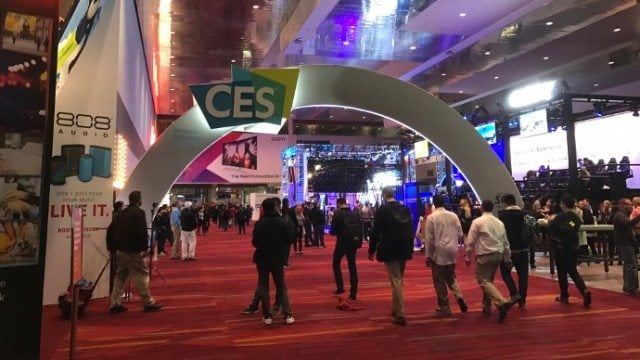
There is a palpable sense of optimism at this year’s Consumer Electronics Show (CES). The advent of deep learning, cloud, automation, and smart tech has driven many companies to think out of the box — heralding a new wave of tech innovations. This isn’t just about increasing computing speed or processing power. Rather, it’s about rewriting the playbook; it is about taking a radical approach to addressing consumer’s current and future needs.
And at CES 2017 – aptly held in a city of boundless possibilities – e27 roamed hall after hall (and picked up a Japanese burrito along the way) to find out some of the cool and awe-inspiring new tech that will take centre stage in the coming months/years. So let’s take a peek.
The big players
Big names almost always steal the limelight at CES, especially with their game-changing potentials:
Nvidia
For most gamers, Nvidia‘s GeForce graphics cards is the reason high end games such as Elder Scrolls 5: Skyrim or Grand Theft Auto 5 look sharp and run smoothly. But the installation process is complicated; one must open their’s PC’s chassis and insert the card into the motherboard, then there is the configuration process, test runs, and other tweaks.
Of course, PCs can be purchased preloaded with these cards but in both scenarios they are pretty costly – and that can put off many casual gamers, many of whom have a tighter budget and little tech DIY skills.
Nvidia CEO Jen-Hsun Huang has now found a method to bridge the divide – using cloud technology.
“We estimate some billion [PC] users with integrated graphics or Macs or older PCs or notebooks that would love to be able to enjoy games but simply don’t have the capabilities to do so … We thought, ‘wouldn’t it be amazing to put a state-of-the-art Geforce gaming PC powered by Pascal in the cloud like AWS [Amazon Web Services]?’ Build a supercomputer, like AWS for enterprises — we would do this for consumers, and as a result these supercomputers in the cloud could be shared by millions of gamers around the world,” said Huang in a packed keynote hall on Wednesday.
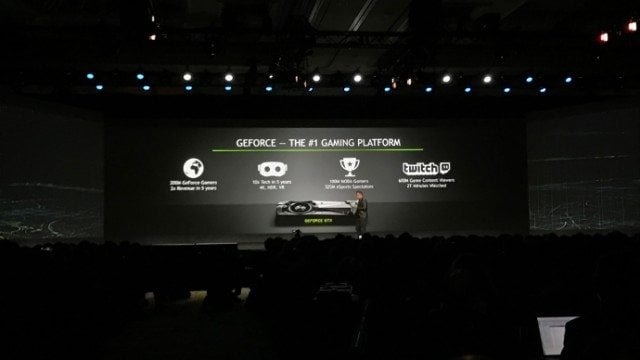
“They could launch a game wherever they want, whenever they want and they could just enjoy state of the art video games with just a click of a button. Wouldn’t that be great? But it is incredibly hard because the computational capability for video games is so high, and the interactivity requirement is so high that any little bit of latency would ruin the experience.”
Also Read: Young but not n00bs: The 8 startups putting Asia on the online gaming map
But after years of refinement, engineering and architecture, Huang said the team has successfully created a cloud-based gaming platform (or Platform as-a-Service) called GeForce Now.

“It turns any of your PCs, with the download of a tiny client, into — with a click of a button — essentially your most powerful gaming PC, and it’s on the cloud. Just one click away,” said Huang.
And there is another advantage of this platform – removing operating system incompatibility barriers. Most PC games rely on clients such as Steam, Uplay, Origin to purchase, install and launch games. But games are separated based on the operating systems. Mac users would not be able to run PC-only games, but now, with GeForce Now, they are able to do so.
In a demo, Huang demonstrated a PC game running on a Mac using GeForce Now. He claimed it would only take about a minute to install and run the games on this new platform (it will also automatically update games). Other details are still sparse at this stage. This is no word on whether all Steam games will be supported, or what other pricing tiers will be offered, but so far, it looks promising.
Besides GeForce Now, Nvidia unveiled a slew of smart devices. The first was the next iteration of Shield TV, Nvidia’s Android-based digital content box. The new Shield offers full 4K resolution and HDR. Huang said that Shield will be the first entertainment platform that will be able to enjoy Netflix and Amazon’s library of content in 4K HDR. Nvidia also worked with gaming company Valve (who made Steam) to create a Steam app for Shield, which allow users to enjoy 4k HDR gaming on the TV while it is playing on the PC.
But the AI integrations are what gives Shield is most significant upgrade. Nvidia partnered with Google to integrate Google Assistant, allowing users to control the device using natural language processing. To complement this function, Nvidia has developed a smart microphone and speaker called Nvidia Spot, allowing users to send commands naturally (or as Huang described it: “ambiently”).
“This little tiny device plugs directly into the wall, and because the computing is done on Shield, we can have a whole bunch of these all over the house. And this little tiny microphone has far field processing, has echo-cancellation so it picks up your speech relatively naturally, 20 feet away. And if you have multiple devices in your room, it also does triangulation of where you are using beam forming…I think in the future, our house is going to become an AI,” said Huang.
Nvidia’s AI ambitions doesn’t stop there, it wants to be the frontrunner of the nascent AI-powered transportation sector. Using its DriverWorks SDK installed on a tiny computer, it wants to help the car drive itself. Using deep learning, it is able to constantly update maps, detect and track other vehicles and potential hazards, as well as find the most optimal routes according to current traffic as they happen.
Also Read: Baidu will build self-driving cars with Nvidia, and test them in Silicon Valley
In situations where the driver is in control, the AI can still play a pivotal support role.
“But there is always going to be places where the confidence of the AI will not be able to drive by itself. But because it knows where it is going to go, it knows its path. It could tell you where you should drive yourself. We believe that the car itself should also be an AI co-pilot.”
By the way it can also read commands via lip reading, which is great in many scenarios such as when you are the designated driver in a party night gone wild.
LG
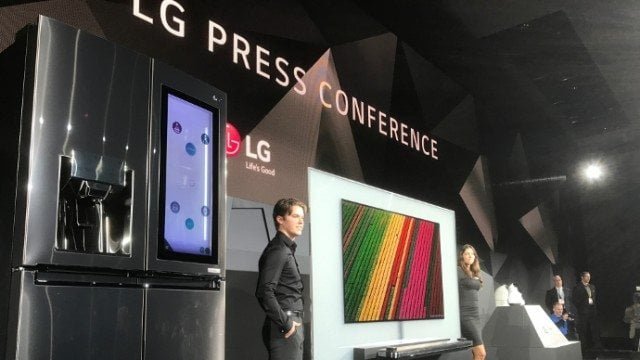
Elsewhere in a separate hall, the South Korean firm unveiled a set of products that will leverage on deep learning technology. The first of which is its smart refrigerator. With Amazon Alexa and LCD screen installed, users can command it to perform functions search for recipes, update kitchen list using their voices. Additionally, it houses a camera inside, so users can use their smartphone to view the contents of the fridge remotely.
LG also announced the launch of its new robot LG Hub Robot, which as it name suggest, is an AI house assistant, with the ability recognise different family faces. It can perform tasks such as switch on the air conditioning or set alarms, all by receiving voice commands fed through the Amazon Alexa platform.
Also Read: Artificial Intelligence 101: A map to understand where we are now
But the most outstanding reveal of LG’s product lineup was about the technology, but rather, design. The new LG smart OLED TV is only 2.57 mm thick — almost like a sheet of paper. Incredible, huh? The race for the slimmest screen continues to get more absurd every year.
The little guys
While it was the big boys who have been stealing limelight for the past few days, the startups and other smaller enterprises provide equally important solutions to everyday fixes:
Relief band
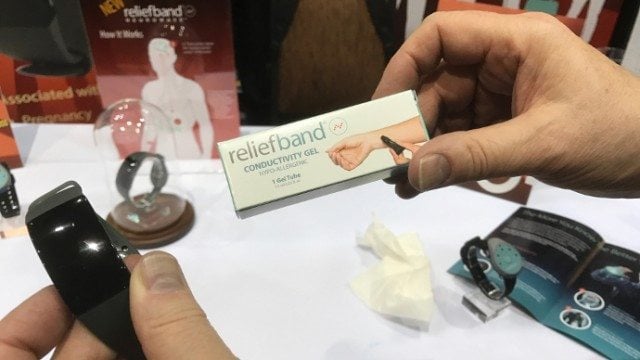
The FDA-approved “wearable treatable” is designed to treat nausea and vomiting associated with motion sickness.
It works using neuro -modulation: modulating a nerve – or acupuncture point – on the wrist. It sends out a frequency or current to stimulate the nerve. Users can select 10 different intensity settings. Once they feel a tingle in their finger, that indicates the device it is working. It users a conductivity gell to conduct the current efficiently. For those who tend to feel queasy on boat/car rides, this is the perfect companion.
Sleep inducer
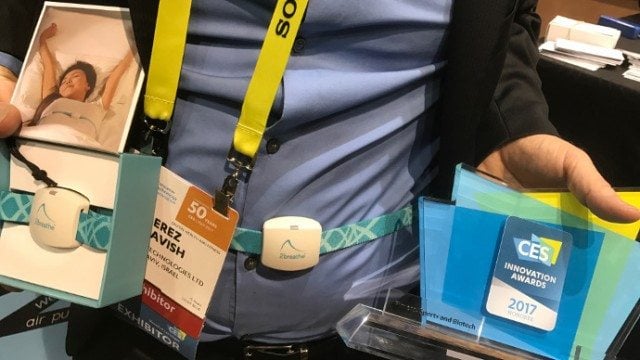
There are many ways of tackling insomnia (though none seems to have worked for me yet). 2breather’s sleep inducer’s concept should be simple to grasp for any club disc jockey. Essentially, the band straps over the abdomen and captures the waveform of the user’s breathing, then sends it to the app that composes a modified inhale and exhale tone in real-time. All users have to do is match their inhale and exhale tone’s with the rhythm in the app, then it app slows down the rhythm, causing user to feel drowsy quickly, then drift off to sleep.
Hearing aid

Traditional hearing aids help to amplify sound, but what if there was one that could send sounds directly through the aids?
This is what Oticon Opn hopes to achieve. By leveraging on IoT, it allows hearing-impaired users to pick up calls, communicate and stream music, similar to a pair of earphones. Volume and programme switches are controlled via a tap on the earphones. Additionally it has a GPS search function should the aids become misplaced.
Personal airbags

An airbag for the hips may sound a little silly. but it would be vital for eldercare and help save millions in medical bills and hospital stay. Using an algorithm ActiveProtective’s Smart Belt can analyse and determine if the user is in an awkward position and analyse the potential impact then deploy the airbag before they hit the ground.
Scollar

There already a few smart pet collars in the market but this one tops them by allowing users to customise their functions. The modular wearable features two expansion slots so engineers or developers can create their own custom module such as health tracking. On its own, the users can set scollar to alert them on feeding times, tracking the pets via GPS. Once the pet has been fed, users can mark the task as finished, so if, for example, your cat has also received his meal from your spouse, then comes running to you in an deceitful attempt for seconds, you can expose its lie by checking the schedule. Busted!
Wrapping up
Of course, as with any CES conference, time will tell which of these technologies at #CES2017 will eventually make it to the mainstream and actually impact our daily lives one way or another. Will it be big-tech innovations like IoT-enabled homes? Or will it be the small things like smart aids for improving our day-to-day lives?
—-
The post From a service that lets old PCs run high end games to a band that stops nausea — the big and small reveals of CES 2017 appeared first on e27.